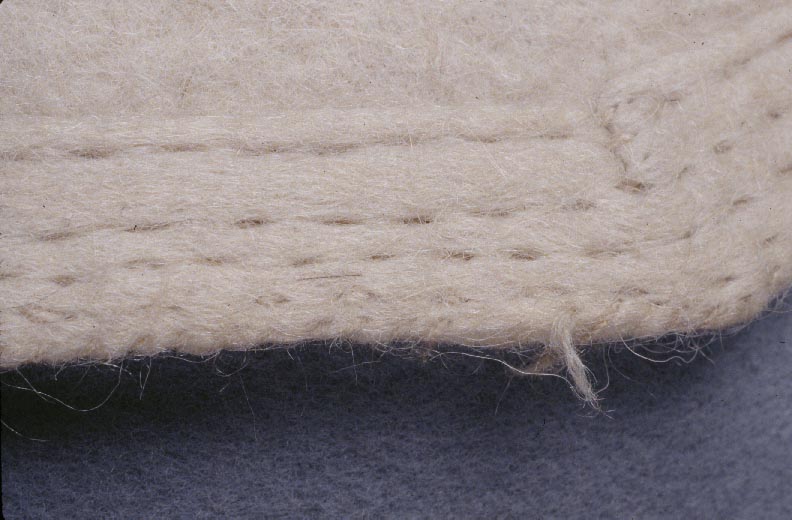|
|
Suondi-Adu
For the Suondi, the most important holiday is the Fire Festival. - Nuosu proverb
|
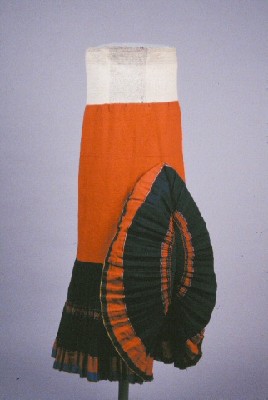
|
Women
Young Woman's Wool Skirt
Bright colors for the young
Young women in the Suondi-Adu region dress up in bright orange or red skirts woven of homespun wool. It might take a mother as long as 6 months to spin, weave, and sew such a skirt for her daughter.
Description:
Woolen skirt with three panels. Top panels is natural, light colored wool, 18cm wide, hand sewn to second panel. Second panel is dyed red, 54cm wide, and in cylindrical shape. Third panel is pleated and 40cm wide. There is a 3cm wide woven band in red, black and white, 24cm from bottom of skirt. A band, 8cm wide, is woven in red, white and black and shows a 2.5cm wide cloth band at bottom of skirt. The edge is trimmed with a yellow woolen cord sewn on by hand.
Back to Top
|
|
|
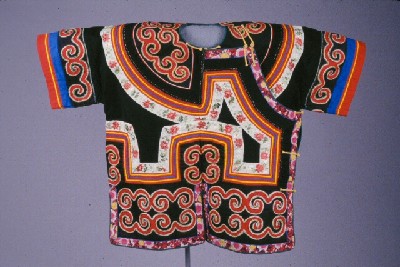
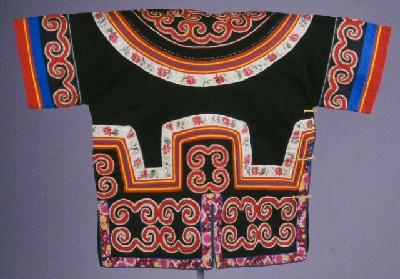

|
Woman's Jacket
Appliqué is a specialty of the Suondi
Intricate appliqué in patterns such as waves, cow's eye, or sheep horns distinguish the short jackets of the Suondi-Adu region.
Description:
The Nuosu technique of appliqué reaches its most advanced development in the Suondi-Adu area, as can be seen in this young woman's short jacket. Seamstress Shamamo Aga has combined traditional appliqué aand couching techniques in the ram's-horn patterns around the edges with commercially produced floral pattern tape.
Back to Top
|
|
|
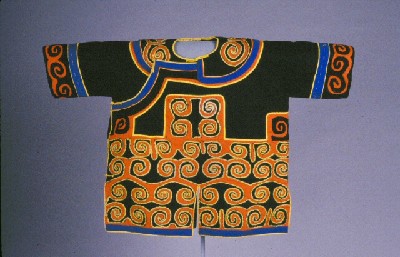
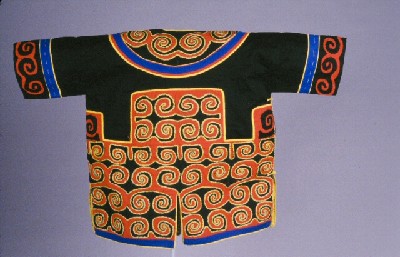
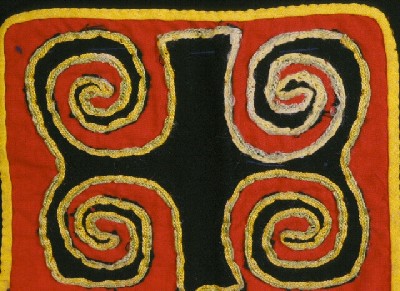
|
Woman's Jacket
Rolled-edget Appliqué
The "cow's eye" pattern of applique is made by layering one color on top of another, and rolling the edge of the underneath layer. On this jacket, the seamstress has added a couched border.
Description:
Cotton, Cloth; Braids, Green, Yellow
Use:
Traditional Suondi young woman's short jacket. It is usually worn over a long sleeved shirt and goes with a pleated skirt. This particular piece was made by a mother for her daughters' wedding.
Back to Top
|
|
|
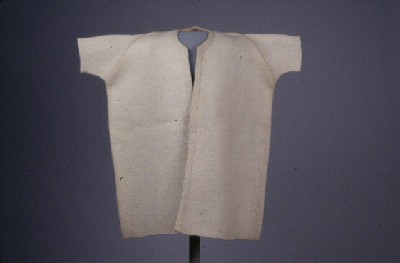
|
Woman's Short Cape
Fake Sleeves
Women in Butuo County wear these dressy capes to go to the market. The sleeves are merely decorative.
Description:
Cream colored cape with stitched piece around neck and down front with four rows of stitching and blanket stitch edge at neck opening. Very short sleeves. Two rabbit ear tabs standing up at center back neck.
How constructed:
Hand sewing; original color of the wool; symmetrical front panels.
Use:
Traditional Adu woman's wool short jacket in Butuo County. It is usually worn when out to the market, visiting friends and relatives as well as attending special occasions such as weddings, funerals, or festivals. The jacket goes with a long shirt. The wearer looks charming while walking. Therefore, it is one of the traditional gowns of Adu women.
Back to Top
|
|
|
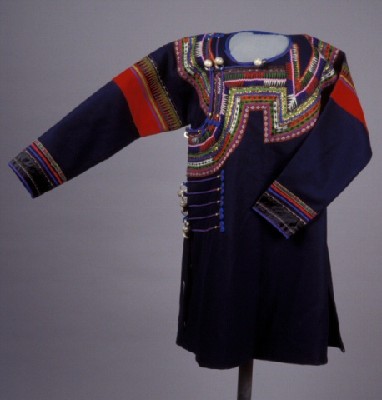
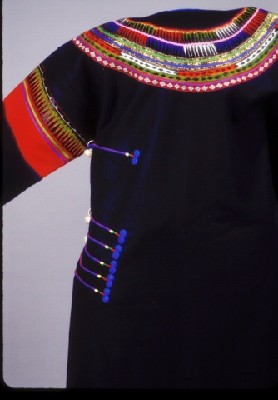
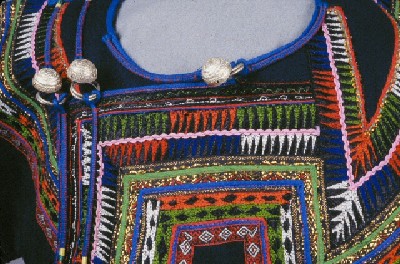
|
Woman's Long Jacket
Silver buttons are wealth
On this long jacket from the Suondi region, buttons of pure silver, the bigger the better, display the wearer's family's wealth. The "military band" style buttons adorn both women's and men's jackets' traditionally a woman's jacket should have seven buttons and a man's should have nine.
Description:
Dark blue wool jacket with right side closure. there are three silver button closures at neck, six button closures on right side opening. Lower five silver buttons are placed next to 16cm long cords attached horizontally to jacket and ending in blue cord spirals. An 11.5cm wide grouping of design elements encircles neck opening and moves to the right side opening. Design consists of braids and bands in reds, green, gold, blue and white. Sleeves are set in. There is an 11.5cm wide band of decorations showing red velvet, blue and green strips and a red and green embroidered section over black fabric. A second design unit is placed near edge of sleeves, 9cm wide, consisting of bands in green floral, red, blue and white strips and red and green stitches over black fabric. Side vent on left is 35cm long and lined with light blue fabric as is right side of jacket. All openings and hems are finished. Back to Top
|
|
|
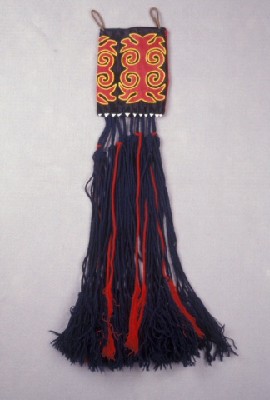
|
Woman's Pouch
Square Purse
The appliqué patterns identify this purse's Suondi origin. Only in the Suondi area did women traditionally carry square purses; elsewhere woman carried triangular purses and square shoulder bags belonged to men.
Description:
Handwoven rectangular bag with ten twisted cords ending in tassels. The front of the bag shows a design in red applique on black satin, showing one full and one half design element. The outlines are couched with yellow cloth strips. Bottom of front panel shows a row of eleven white cotton triangles, 5mm long. Back is made of red velvet. A stiff material is placed between front panel and lining. Two 5.5cm long loops are placed at the top at outside corners of bag. The cords/tassels consist of black and red twisted strands of wool, 52cm long.
Use:Traditional Adu woman's waist purse in Butuo county. It is worn at the waist on the right hand side as a fashion accessory of women's clothes. It is also used as a sewing kit. Back to Top
|
|
|
(use second, sidelong view rather than the face-on one)
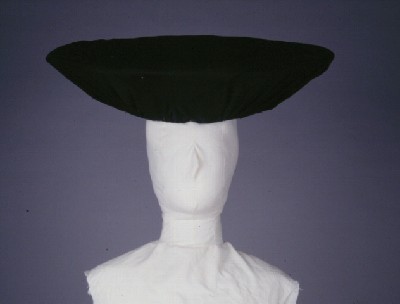
|
Mother's Hat
A Fading Fashion
Traditionally, Suondi women wore these moon-shaped hats when they became mothers. But they are rather cumberson, and in recent years they have been replaced by blue cotton Chinese workers' caps.
Description:
Black cloth hat over a conical stiff frame. Wide top of hat is covered with black fabric pieced together with eight pie-shaped cloth pieces, then folder over rim of hat and gathered at narrower rim for head. HOW constructed: Handmade. The frame is made of bamboo skin stripes into a conical shape, narrow at the bottom and wider towards the crown. It is covered with a black cotton cloth and held in place by fastening along the rim of the hat.
Use:
Black bamboo-framed hat for woman who has given birth in Suondi area. The jackets and pleated skirts of women who have given birth are similar to those of girls, except that there are less embellishments on the older women's clothes. The yoke, hem and cuffs of the woman's jacket are appliqued with broad black bands and decorated with narrow strips in red, yellow, and green. "Cockscomb" pattern of colored cloths is the major design motif. The color of the jacket is usually in plain colors such as blue, green, purple, black and white. Back to Top
|
|
|
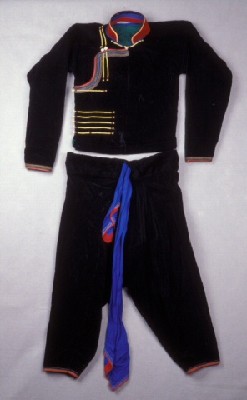
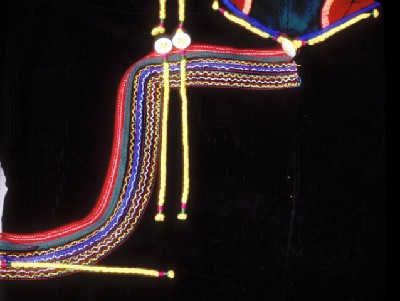
|
Men
Man's Suit: by Hmamo Yudur
Small Trouser Legs
"Small trouser legs" is a name not only for the fitted cuffs of Suondi men's pants, but for the Suondi region and its people. The trousers are also known as "horse pants." The "military" looking button closures on the right side of the jacket are also characteristic of this region.; they are often closed with large Suondi-style semispherical silver buttons. This suit would be worn by a young man or boy. The jacket has an attached stiff collar. Contrast these small trouser legs with the medium legs of the Shynra and the *big pant legs* of the Yynuo.
Back to Top
|
|
|
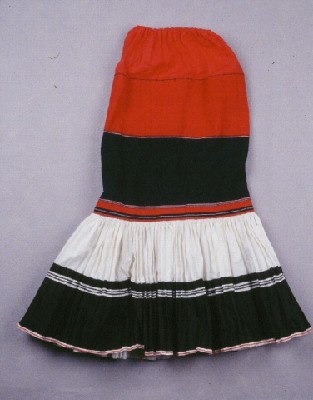
|
Children
Girl's Skirt: by Lama Chyvie
A sign of childhood
In traditional Nuosu society, little girls wore skirts, but they were of different design from those worn by their mothers, and called by a different name, shahla instead of mbo. When a girl reached the age of 13 or 15, she went through a ceremony called shahla ge, or "changing the skirt," which gave her the status of an adult woman. In addition to her skirt, she also changed her earrings and hairstyle, and began wearing a headcloth. Nowadays, little girls rarely wear skirts, because they are time-consuming to make, and girls grow out of them so soon.
Description:
Little girl's skirt with five panels. First panel is made of red cotton, 12cm wide, gathered at top with an elastic cord. Second panel is woven in red, 12.5cm wide with a woven edge in black next to top panel and a black and white woven line next to third panel. The third panel is woven of black wool, 18cm wide, the lower 3.5cm showing woven red, black and white lines. The second and third panels are barrel shaped. Fourth panel is pleated of white cotton, 13.5cm wide, and continues under the fifth panel ending in a seam holding fifth panel top and lining together. Fifth panel is made of black cotton, pleated, 14.5cm wide. A 2cm wide band of white fabric is showing near top of that section couched with two lines of narrow, black fabric. The bottom edge consists of 0.7cm wide white fabric, couched with a narrow red cord. Skirt is sewn together at side.
See:Mountain Patterns, by Stevan Harrell, Bamo Qubumo, and Ma Erzi, page 23.
Back to Top
|
|









